
Asperti A.Categories,types,and structures.1991
.pdf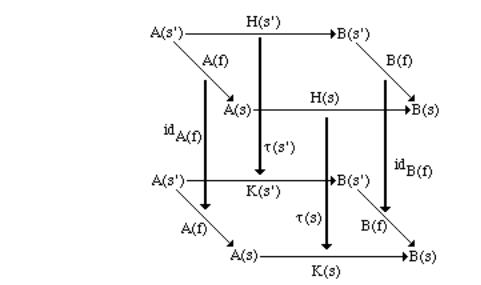
7. Indexed and Internal Categories
(Vertical) composition of S-indexed natural transformations is defined componentwise, that is, given
H, K, L : A→B,τ: H→K and |
ρ: K→L, ρ ° τ: H→L is given by (ρ ° τ)(s) = ρ(s) ° τ(s). This is a |
|
good definition since, for any |
f: s→s' |
in S and any object a in A(s'), |
(ρ ° τ)(s)A(f)(a) = |
(ρ(s) ° τ(s))A(f)(a) |
|
=ρ(s)A(f)(a) ° τ(s)A(f)(a)
=B(f)(ρ(s')a) ° B(f)(τ(s')a)
=B(f)(ρ(s')a ° τ(s')a)
=B(f)((ρ ° τ)(s')a).
7.1.5Definition Let A, B be S-indexed categories, H: A→B, K: B→A be S-indexed functors, and η: idA→K°H, ε: Η°K→idB be S-indexed natural transformations. <H, K, η, ε> : A→B is an
S-indexed adjunction if and only if
(Kε) ° (ηK) = idK (εH) ° (Hη) = idH .
The notion of indexed adjunction is the obvious generalization of the usual notion of adjunction. In particular it is easy to check that for any object s of S, <H(s), K(s), η(s), ε(s)> : A(s)→B(s) is an adjunction in the usual sense.
The main problem with the definition of adjunction as a quadruple <H, K, η, ε> : A→B is in its generalization of the case with parameters (remember that the definition of exponents requires an adjunction of this kind). As a triple, an indexed adjunction can be defined in the following, somewhat informal, way:
7.1.6 Definition Let A, B be S-indexed categories, and H: A→B, K: B→A be S-indexed functors. <H, K, φ> : A→B is an S-indexed adjunction if and only if, for every f: s→s' in S,
134
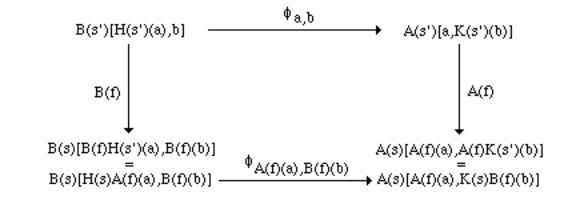
7.Indexed and Internal Categories
i.<H(s), K(s), φ(s)> : A(s)→B(s) is an adjunction
ii. φ(s) ° B(f) = A(f) ° φ(s') ( φ(s) ° f* = f* ° φ(s') )
Equation ii expresses the naturality of the isomorphism φ with respect to the index s. Spelling out the composition in ii, we can say that for any f: s→s', a in A(s'), b in B(s'), and g: H(s')(a)→b in B(s'),
φ(s)A(f)(a),B(f)(b) (B(f)(g)) = A(f) (φ(s')a,b(g))
Suppose we have an adjunction <H, K, η, ε> : A→B. Then we obtain φ in definition 7.1.6 by letting, for any a in A(s), b in B(s), and g: H(s)(a)→b in B(s),
φ(s)a,b(g) = ε(s)b ° H(s)(g)
As we know from chapter 5, for any s in S, φ(s)a,b: B(s)[H(s)(a),b]→A(s)[a,K(s)(b)] is an
isomorphism. We now prove that the previous definition of |
φ(s) satisfies equation ii in definition |
|
7.1.6. For any f: s→s', a in |
A(s'), b in B(s'), and g: H(s')(a)→b in B(s'), we have |
|
A(f) (φ(s')a,b(g)) = |
A(f) (ε(s')b ° H(s)(g)) |
by def. of φ(s') |
= |
A(f) (ε(s')b) ° A(f) (H(s)(g)) |
since A(f) is a functor |
= |
ε(s)B(f)(b) ° H(s)(B(f)(g)) |
by naturality of ε and H |
= |
φ(s)A(f)(a),B(f)(b) (B(f)(g)) |
by def. of φ(s) |
Conversely, given an adjunction <H, K, φ> : A→B, we obviously obtain η, ε by the following: η(s)a = φ(s)a,H(s)(a)(idH(s)(a)) : a→K(s)H(s)a
ε(s)b = φ(s)−1K(s)(b),b(idK(s)(b)) : H(s)K(s)b→b.
Definition 7.1.6 has a straightforward generalization to the case with parameters.
7.1.7 Definition |
Let A, B, D be S-indexed categories, and H: A×D→B, K: Dop×B→A be S- |
|
indexed functors. <H, K, φ> : A→B |
is an S-indexed adjunction with parameters in D if |
|
and only if, for every f: s→s' in S, |
|
|
i. |
<H(s), K(s), φ(s)> : A(s)→B(s) is an adjunction with parameters in D(s); |
|
ii. |
φ(s) ° B(f) = A(f) ° φ(s') |
( φ(s) ° f* = f* ° φ(s') ). |
135
7.Indexed and Internal Categories
7.2Internal Category Theory
A category C is small when the collection MorC of its morphisms is a set. Clearly, then, the collection ObC of objects of C is also a set. Moreover, there are set-theoretic functions DOM,COD: MorC→ObC that specify source and target of every morphism, a function ID: ObC→MorC that defines the identity morphism for every object, and a partial function COMP: MorC×MorC→MorC for the composition. Given two morphisms f and g, their composition is defined if and only if DOM(f) = COD(g); the domain of COMP is thus the set {(f,g) | DOM(f) = COD(g)}, that is, the pullback of the two functions DOM,COD: MorC→ObC. All these functions must also satisfy the obvious equations stating the behavior of the identity morphism with respect to composition, the associativity law for compositition, and the rules which specify domain and target for the identity morphism and for the result of a composition. Thus every small category may be completely described internally to the category Set, which becomes a sort of “universe of discourse.” The previous discussion, however, has made very little use of the specific structure of Set; we only needed the existence of pullbacks in order to define the correct domain of the function COMP. In this section, we will show that most of the basic definitions of Category Theory, such as category, functor, natural transformation and so on, can be recasted inside any category with all finite limits. This means that any such a category may be considered a fairly big universe inside which we can carry out constructions with almost the same confidence as we do in Set. This branch of Category Theory is known as “internal,” since it describes notions of Category Theory by using the categorical language as a metalanguage.
For many fields of mathematics, from Set Theory to Algebra and Geometry, treatments in the language of Category Theory, even of well-known results, have never been worthless since most of the time they created a new, sometimes unexpected, sense of explanation. The same holds for Category Theory itself: in a sense, Internal Category Theory plays with respect to the general theory the same role that Category Theory plays with respect to Set Theory. If a notion of Category Theory cannot be described internally in a simple way, then there is surely something in that notion that is worth spelling out. As we shall see, this is, for example, the case of the hom-functor and, more generally, of every presheaf.
Internal Category Theory allows us to work in different universes than Set. This possibility turns out to be very relevant in several cases, and in particular for the application we aim at in chapter 11, where Internal Category Theory will be applied to the study of categorical models for the polymorphic lambda calculus. In that case, the possibility of working in more constructive categories than Set turns out to be essential, as it is known that the standard set-theoretic interpretation of the first order typed lambda calculus cannot be extended to a model of the second order typed lambda calculus.
136

7. Indexed and Internal Categories
In the following, E will always denote a category with all finite limits. Our first step is to mimic within E the presentation, within Set, of a small category. Thus the collections of objects and morphisms will be viewed as objects of E.
Notation We write X×0Y (instead of X×ZY) for the pullback of X and Y along morphisms with common target Z; <,>0 will be used as a “pullback pairing” map, that is, given (suitable) h:W→X and k:W→Y, we have <h,k>0:W→X×0Y; the pullback projections will be usually (but not always) denoted by the upper case Greek letter Π, indexed with a number or some other symbol.
7.2.1 Definition c = (c0,c1,DOM,COD,COMP, ID) is an internal category of E (c Cat(E)) iff:
c0, c1 ObE
DOM, COD : c1 → c0
COMP : c1 ×0 c1 → c1 where c1 ×0 c1 is the pullback of DOM, COD : c1→c0 ID : c0 → c1
and moreover
137
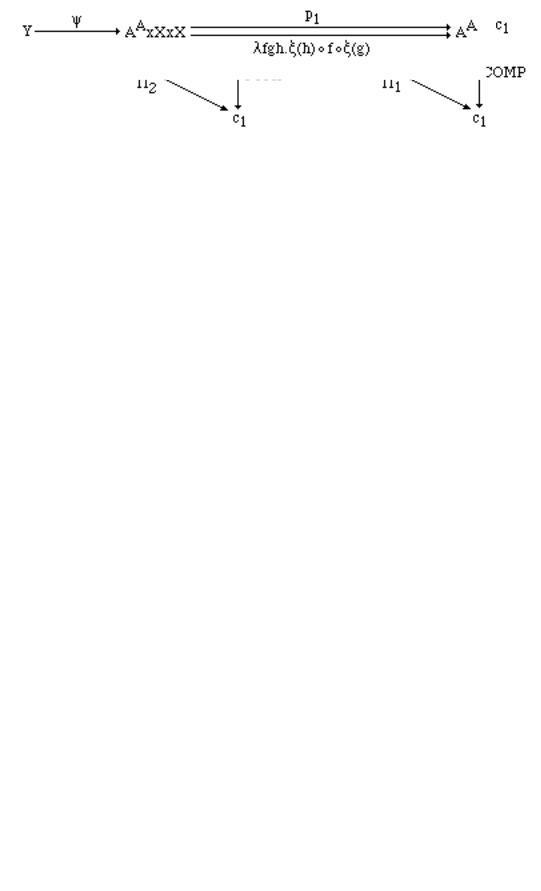
7. Indexed and Internal Categories
Note that in the diagram expressing the associativity of composition there is an implicit isomorphism between c1×0 (c1×0 c1) and (c1×0 c1) ×0 c1. Indeed,
COMP ˚ (COMP ×0 id) : (c1 ×0 c1) ×0 c1 → c1 COMP ˚ (id ×0 COMP) : c1 ×0 (c1 ×0 c1) → c1.
In the following, this isomorphism will be always skipped in order to maintain the notation at a simpler level.
7.2.2 Examples 1. Given an object e in E, the internal discrete category associated with |
e |
|
is (e,e,ide,ide,ide,ide). |
|
|
2. Let E be a CCC with all finite limits, and let A |
be an object of E. It is possible to define |
|
internally to E a category that plays the role of the category of retractions over A. |
|
|
Let m = Λ( eval ˚ (id×eval) ) : AA×AA →AA |
the internal composition map, that is let |
m |
=λ(f,g).g ˚ f. Since E has all finite limits, it has equalizers for every pair of morphisms. Let then (X, ξ) be the equalizer of
id : AA →AA
m ˚ <id,id> : AA →AA
The function m ˚ <id,id> : AA →AA is λf. f ˚ f; thus the object |
X |
represents the subset of |
AA of |
||
all those functions |
f such that f = f ˚ f , i.e., X is an internalization for the set of retractions in |
AA. |
|||
X plays the role of |
c0 in the internal category we are defining. |
|
|
|
|
Intuitively, a morphism between two retractions g and h |
is a triple (f,g,h), where |
f |
is a |
||
function from A to A such that f = h ˚ f ˚ g. |
|
|
|
|
|
In order to internalize this definition we use the equalizer (Y,ψ) |
of |
|
|
||
p1 : AA×X×X → AA |
|
|
|
|
|
m ˚ (m×id) ˚ < ξ ˚ p3 , p1, ξ ˚ p2 > : AA×X×X → AA |
|
|
|
||
Note that m ˚ (m×id) ˚ < ξ ˚ p3 , p1, ξ ˚ p2 > is just λfgh. ξ(h) ˚ f ˚ ξ(g).
138
7. Indexed and Internal Categories
COD and DOM are obviously defined by the following equations: DOM = p2 ˚ ψ
COD = p3 ˚ ψ
For ID, note first that by definition of ξ , m ˚ < ξ, ξ > = id ˚ ξ = ξ and, therefore, (λfgh. ξ(h) ˚ f ˚ ξ(g) ) ˚ < ξ, id, id > = ξ.
Thus < ξ, id, id >: X →AA×X×X equalizes p1 and λfgh. ξ(h) ˚ f ˚ ξ(g), and ID: X →Y is the unique arrow such that ψ ˚ ID = < ξ, id, id >. Note that
DOM ˚ ID = p2 ˚ ψ ˚ ID = p2 ˚ < ξ, id, id > = id COD ˚ ID = p3 ˚ ψ ˚ ID = p3 ˚ < ξ, id, id > = id.
Finally, we must define COMP: Y×0Y→Y. The idea is that (f,g,h) ˚ (f',k,g) = ( f ˚ f', k, h ). We start defining an arrow M: Y×0Y→ AA×X×X such that M((f,g,h), (f',k,g)) = ( f ˚ f', k, h ); next we prove that M equalizes p1 and λfgh. ξ(h) ˚ f ˚ ξ(g). Then COMP is the unique arrow from Y×0Y to Y such that ψ ˚ COMP = M.
3. Given a function f: U→C, consider the C-indexed collection of sets {G(c) = f-1(c)}c C. We can form a small category C , which has C as set of objects, and with hom-sets C [c,c'] = Set[G(c),G(c')]. Composition and identities are inherited from Set. The previous construction can be generalized to a generic topos E: given f: U→C in E, there is an internal category Full(f) that plays the role of the full subcategory generated by the fibers of f. Full(f)0 is C; Full(f)1, together with the map <DOM,COD>: Full(f)1→C×C, is defined as the exponent p1*(f)p2*(f) in the slice category E/C×C, where
p1*(f) = f×id: U×C→C×C p2*(f) = id×f: C×U→C×C
are respectively the pullbaks of f along the first and second projections. Composition is obtained from the internal composition map m: p2*(f)p1*(f)×p3*(f)p2*(f)→p3*(f)p1*(f) in the slice category E/C×C×C. Similarly, the identity morphism ID: C→Full(f)1 is obtained from the “inclusion of identities” Λ(idf): idC→ff in the slice category E/C.
Our exposition of Internal Category Theory proceeds with the definition of “internal functor.” Again, the intuition of a standard functor helps in the understanding of the following definition; a functor F between two small categories C and D is a pair of functions in Set, F = (F0, F1), where F0: ObC→ObD, F1: MorC→MorD; moreover F1 distributes with respect to composition and preserves identity.
7.2.3 Definition Let c,d Cat(E). F is an internal functor from c to d (F: c→d) iff F = (f0, f1) with f0 E[c0,d0], f1 E[c1, d1], and F satisfies
139
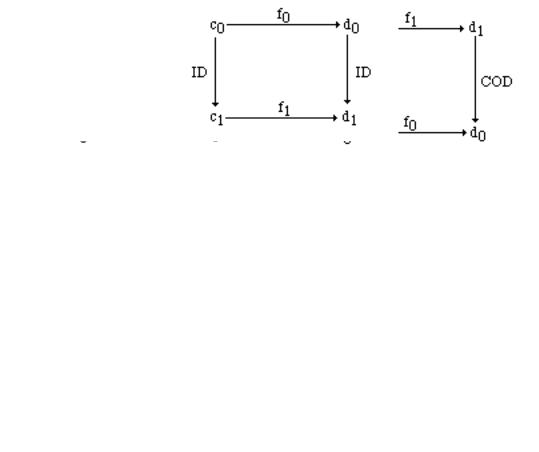
7. Indexed and Internal Categories
7.2.4 Definition The category Cat(E) has as objects the internal categories of E and as morphisms the internal functors. Composition of functors is defined in the obvious way; that is, given F = (f0,f1) and G = (g0,g1), F ˚ G = (f0 ˚ g0, f1 ˚ g1).
For example, Cat(Set) is the category Cat of all small categories, i.e., of all those categories
whose class of morphisms is a set.
It is easy to carry out the usual constructions on categories inside Cat(E). For example, given c = (c0, c1, DOM, COD, COMP, ID), we can define the dual category cop = (c0, c1, COD, DOM, COMP˚α, ID), where α = <Π2,Π1>0 : c1×0 c1 ↔ c1×0'c1. _op : Cat(E) → Cat(E) is a functor.
The product of two internal categories c and d is the category c×d = (c0×d0, c1×d1, DOMc×DOMd, CODc×CODd, (COMPc×COMPd) ˚ β, IDc×IDd) where β is the isomorphism (c1×0c1)×(d1×0d1) ↔ (c1×d1)×0(c1×d1). Clearly, _×_ : Cat(E)×Cat(E) → Cat(E) is a
functor. |
|
7.2.5 Definition Let F = (f0,f1) and G = (g0,g1) |
be two internal functors from c to d. τ is |
an internal natural transformation from F to G |
(τ: F→G) iff τ E[c0, d1] and satisfies |
140
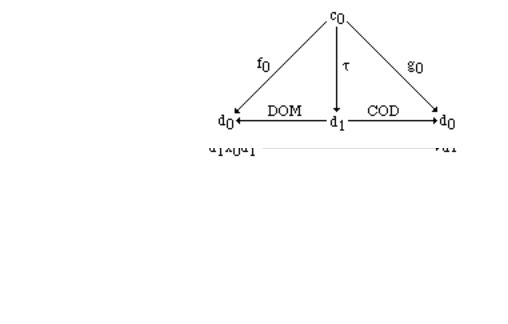
7. Indexed and Internal Categories
7.2.6 Definition Given two internal categories c and d, Nat(c,d) is the category that has internal functors from c to d as objects, and internal natural transformations as arrows. Given σ: F → G and τ: G→H, τ ˚ σ = COMPd ˚ <τ,σ>0 : F → H
7.2.7 Example In this example we define PER as an internal category of ω-Set. PER is the category of partial equivalence relations constructed over Kleene’s applicative structure (ω,.). Remember that the partial application . : ω×ω→ω is defined by m.n = ϕm(n), where ϕ: ω→PR is an acceptable gödel numbering of the partial recursive functions. We will use the following notation:
n A m iff |
n is related to m |
by A , |
{n}A = {m | |
m A n } the equivalence class of n with respect to A, |
|
Q(A) = {{n}A | n dom(A)} |
where dom(A) = {n/ nAn} . |
|
The morphisms of the category are defined by
f PER[A,B] iff f : Q(A)→Q(B) and n p (pAp f({p}A) = {n.p}B ) .
Thus the morphisms in PER are “computable” in the sense that they are fully described by partial recursive functions, which are total on the domain of the source relation.
Note that PER is a small category, as the partial equivalence relations (p.e.r.’s) form a set as well as their morphisms; thus Set contains PER as an internal category. Though, since a crucial property of PER is that its morphisms are “computable,” we are interested in introducing a similar notion in the category of sets by a realizability relation “|_” with respect to numbers.
The category ω−Set is defined as follows: objects: (A,|_) ω−Set iff
A is a set and |_ ω×Α, such that a A n |_ a . morphisms : f ω−Set[A,B] iff
141
7. Indexed and Internal Categories |
|
_ |
. _ |
f : A→B and n a A p | |
A a n p | B f(a) |
(notation : n |_A→B f and we say that n |
realizes f ). |
Similarly as for PER, each morphism in ω−Set is “computed” by a partial recursive function, which is total on { p | p |_Aa } for each a A .
It is not difficult to prove that ω−Set is a CCC with all finite limits. The terminal object is
simply (1, |_1) , where 1 is the singleton set and |_1 = ω×1. |
If [ , ] is a coding of pairs of |
|||
numbers, then |
(A×B, |_A×B) is given by |
[n,m] |_A×B (a,b) iff |
n |_A a |
and m |_B b . As for |
exponents, let |
[A→B] = ({f: A → B | f ω-Set [A,B] }, |_A→B), where |
|_A→B is given as |
||
above. |
|
|
|
|
There is a simple way to embed Set into ω-Set. Let Σ : Set→ω-Set be given by |
||||
|
Σ(S) = (S, |_S) with |
|_S = ω×S , the “full” relation. |
|
|
Σ is defined as the identity on morphisms, since by the definition of |_S , all functions are realized by all numbers for total recursive functions. Σ is a full and faithful functor, which preserves all finite limits and exponents.
This embedding suggests how to turn PER into an internal category of ω-Set (recall that the exponent of A and B in PER is given by m (A→B) n p,q (p A q m.p B n.q) ). Indeed, M = (Mo,M1,domM,codM,idM,compM) is defined by
1.Mo = (PER, |_M) where |_M = ω× PER;
2.M1 = ({<{n}A→B,A,B)> | A,B M, n (A→B) n }, |_1)
where m |_1 < {n}A→B,A,B> iff m (A→B) n ;
3.domM(<{n}A→B,A,B)>) = A;
4.codM(<{n}A→B,A,B)>) = B;
5. |
idM(A) = <{i}A→A,A,A)> |
where i = λx.x is a number for the identity function; |
6. |
compM(<{n}A→B,A,B)>,<{m}B→C,B,C>) = <{b.m.n}A→C,A,C)> |
|
where b = λxyz.x(yz).
We have to check that M is an internal category of ω-Set. It will be easy, in view of the set-theoretic nature of its morphisms. Essentially, one has to prove that the required morphisms are functions that happen to be realized.
Note first that ω-Set[A,Σ(S)] = Set[A,S] for any A = (A, |_A) in ω-Set and any set S, since |_S is the full relation and, hence, any function is realized by any index. Thus, the set-theoretic functions domM, codM are also morphisms in ω-Set.
M1 is a set of triples: equivalence class, domain, and codomain. The realizability relation in M1 is nontrivial and, hence, one needs to give explicitly the realizers of idM and compM. Indeed, idM is realized by λx.i, the constant function equal to an index i for the identity function. As for compM, it is defined as usual only on a subset of M1×M1, namely, where the target of the first morphism coincides with the source of the second. In the general setting, this is expressed by the use
142
7. Indexed and Internal Categories
of a pullback as a source object for COMP. In this specific case, that pullback becomes simply the set of pairs such as (<{n}A→B,A,B)>,<{m}B→C,B,C>). Then the realizer for compM is b', for b'[n,m] = bnm, where b is an index for the composition of functions, an operation that may be uniformly and effectively given over (ω,.) .
7.3 Internal Presheaves
We have already remarked that every small category may be regarded as an internal category in Set. However, in Set we are accustomed to considering not only functors from one small category to another, but also, for example, functors from a small category to a large one and in particular to Set itself. A significant example is hom-functor from a small category to Set. Surprisingly, it is possible to cope at the internal level also with this problem, by means of the notion of internal presheaf.
If F is a functor from Cop to Set, then the component F |
Ob |
of F is a collection {F(c)} of sets |
||||||
|
|
|
|
|
|
|
|
|
indexed on objects of |
C. Such a collection can be regarded as a function ρ0: X→ObC, |
where |
X = |
|||||
{(c,m)/ m F(c)} and |
ρ0(c,m) = c. Then FOb(c) ρ0-1(c). Now, given an arrow |
f: d→c, |
and |
|||||
an object (c,m) ρ0-1(c), |
define a function ρ1 by |
ρ1((c,m),f) = (d,F(f)(m)). The function |
ρ1 |
|||||
describes the behavior of F |
on morphisms. Note that |
ρ1((c,m),f) is defined if and only if cod(f) = |
||||||
ρ0(c,m) = c; |
thus, the domain of ρ1 is the pullback |
Z (in Set) of cod: MorC→ObC and |
ρ0: |
|||||
X→ObC. Let |
Π2: Z→MorC and Π1: Z→X, be the associated projections. Note that |
|
||||||
1.ρ0( ρ1((c,m), f) ) = ρ0( (d,F(f)(m)) ) = d = dom(f) = dom( Π2(f,(c,m)) ) ;
2.ρ1((c,m),f°f') = (d,F(f°f')(m)) = (d,F(f')(F(f)(m))) = ρ1((d',F(f)(m)),f') =
=ρ1(ρ1(f,(c,m)),f');
3.ρ1((c,m), idc) = (c,F(idc)(m)) = (c, m).
That is, more concisely:
i.ρ0 ° ρ1 = dom ° Π2 : Z→ObC;
ii.ρ1 ° (idX ×0 comp) = ρ1 ° ( ρ1 ×0 idMorC) : X×0MorC×0MorC → MorC;
iii.ρ1 ° <idX, ID ° ρ0>0 = idX,
where ×0 denotes pullback product and ID: ObC→MorC is the function that takes an object c to idc. Conversely, given a small category C, and a triple (X, ρ0: X→ObC, ρ1: X×0ObC→MorC ) that satisfies equations i-iii above, it is possible to define a presheaf F: Cop→Set by letting
c ObC |
F(c) = ρ0-1(c) |
||
f C[c',c], (c,m) F(c) |
F(f)(c,m) = ρ1((c,m),f). |
||
Equation i states that ρ1((c,m),f) |
is in |
F(c'), indeed c' = dom(f) = dom(Π2((c,m),f)) = |
|
ρ0(ρ1((c,m),f)), and thus, by definition of |
F, |
F(f)(c,m)=ρ1((c,m),f) F(c'). |
|
Equations ii and iii express the fact that |
F is a contravariant functor. Indeed, |
||
F(f˚g)(c,m) = ρ1((c,m),comp(f,g)) |
by def. of F |
||
= ρ1( ρ1((c,m),f), g) |
by (ii) |
||
143
